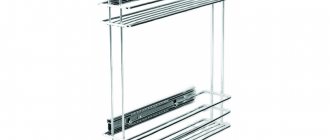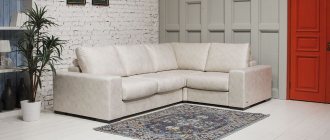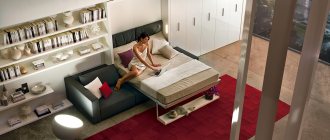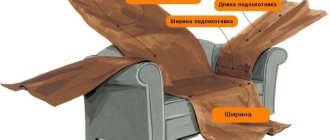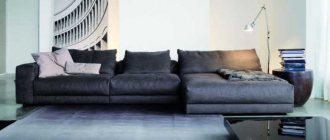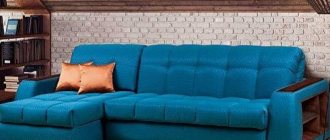Choice of shape and design
To choose a cover design, you need to take into account the dimensions and shape of the furniture. For a two or three seater sofa without armrests, a regular rectangle is best. Another good option is a square of fabric with tassel decor along the long edge of the product.
The design of the product with armrests assumes the presence of a trapezoidal-shaped bedspread. However, it can look a little bulky and is not always suitable for small rooms. If your apartment has a small, compact corner sofa (these are often sold in IKEA stores), it is better to sew a U-shaped blanket on it. The only problem in this case is the difficulty of constructing the pattern; a novice craftswoman may need the help of more experienced needlewomen.
The design of the product largely depends on the style in which the interior is decorated. You should select the color scheme of the sofa cover based on the decoration of the room, the appearance of other furniture and accessories.
We sew a sofa cover easily and simply!
Sewing a replacement sofa cover is a great alternative to replacing old upholstery. In addition, the covers are removable, which means they can be washed. Sew several covers and change them from season to season or depending on the occasion. Your furniture will be reliably protected from dust and grime. It will retain the natural color of the upholstery for a long time and will not be damaged by the claws of pets.
Look at the options for sofa covers that we suggest you make with your own hands.
When choosing fabrics for a cover, you can come up with unexpected combinations and different types of finishes.
Follow our instructions and you can easily change the style and mood of your living room.
The cover consists of three elements: a lining, a cross-shaped top and decorative elements on the corners of the sofa. The top of the cover in the photo below is made of tapestry fabric, which contrasts with the iridescent silk of the corner elements.
Making a cover pattern
Start with four basic measurements: cover length, width, armrest length, and armrest width.
Taking measurements
For the top of the case:
1. To determine the length of the cover, measure the sofa from front to back, starting from the floor in front of the sofa and ending with the floor behind the back, plus 25-30 cm for a loose fit, plus allowances for hems. 2. To determine the width of the cover, measure the sofa seat plus seam allowances. 3. The length of ONE armrest is measured from the seat through the armrest to the floor plus 25-30 cm for a loose fit, plus allowances for hems. 4. To determine the width of the armrest, measure the width of the sofa seat plus seam allowances.
For lining:
Length = length of the cover according to point 1 above. Width = the width of the cover (point 2 above) plus two lengths of the armrest (point 3 multiplied by 2), and minus 2 allowances for hems.
Sewing Tips:
Lay out the parts of the cover on the sofa with the wrong side up, determine where to sew the side parts (armrests) and baste them to the central part.
Lining
Case design option
Elegant case with brocade top
To prevent the fabric of the cover from “wrinkling” when you sit on it, prepare wooden rods equal to 5/8 of the length/width of the sofa and recess them between the seat and backrests. If the sides of the sofa are curved, use a PVC water pipe of the appropriate length for the same purpose, bending it into the desired shape.
Our option for sewing a cover for a sofa, consisting of a lining and a top, allows you to choose the fabric for decorating the sofa that you like, but it is not enough to sew a whole cover. For example, pieces of antique fabrics.
Decoration of corners
The corners of the case can be designed in different ways, with careful selection of accessories, and get impressive results. Use our ideas to start imagining!
Part of the cover from the armrest is tied into a large knot
The case is laced with small brass grommets
Lace-up buttons
Fastening with decorative buttons, snaps or zippers
Instead of a cord, you can use belts with rings, which are sewn from the main fabric of the top of the case
Let your home always make you happy, give you warmth and comfort. Success in creative work! If you liked the ideas! Share them with your friends!
Manufacturing materials and tools
A sofa cover can be made from different fabrics. The choice depends on individual preferences. The easiest way to care for fleece and tapestry. They practically do not fade in the sun, they can be washed in an automatic machine.
| Velours | Looks impressive, but attracts dust and static electricity |
| Flock | Externally similar to velor, but costs less and has a shorter service life |
| Microfiber | The fabric is easy to care for, but easily absorbs and retains foreign odors for a long time. |
| Cotton | Natural fabric, does not cause allergic reactions, can be used for covers on children's furniture. Disadvantages: fades when washed and fades in the sun |
| Jacquard | Durable fabric that lasts a long time, maintaining color and structure. But the material can become very wrinkled and stretched during automatic spinning during machine washing. |
Development of a drawing of a corner sofa, assembly with your own hands step by step.
The main requirements for the material for sewing a cover are practicality and hypoallergenicity (especially if you need to sew a blanket for children). Ease of care and cleaning is also very important. Color fastness matters. And, of course, it’s good when the fabrics are pleasant to the touch, this creates additional comfort.
You should purchase fabric in a store so that you have enough to spare when sewing. If there is still material left after cutting, you can use it to sew decorative sofa pillows to match the cover.
Velours
Jacquard
Microfiber
Flock
Cotton
Sizing
To correctly determine the size of the cover, you need to measure the dimensions of the sofa. This is done in stages, using a flexible measuring tape or tape measure. The following manipulations are performed:
- Visually you need to divide the furniture into several approximately equal rectangles.
- You need to stand facing the seat and determine the dimensions of the left and right sides of the protrusion.
- Measure the backrest from the armrest to the corner.
- Find out the parameters of the handrails: first the length, and then the width. Be sure to measure both; they may differ slightly.
Next, the resulting values are added and multiplied by two. Then you can roughly draw a sofa on paper and transfer all the parameters there. Each number must be written down immediately after measurement so as not to forget. After this, you can begin purchasing material for sewing the cover and creating a pattern on special paper. The recommended margin for purchasing fabric is from 0.5 to 1.0 m. This is especially important for inexperienced craftswomen, since measurements may be inaccurate.
Step-by-step sewing instructions
It’s not difficult to sew a blanket or cover with an elastic band with your own hands at home. The main thing is to make the pattern correctly. You also need to follow the step-by-step instructions exactly.
Effective ways to remove the smell of cat urine from a sofa and armchairs
Pattern of parts
The easiest way is to use ready-made patterns with size adjustments. It is necessary to transfer them to the fabric, taking into account the dimensions of specific furniture without armrests or with them. To do this, the diagram must be printed on a printer. Next, the finished image is cut in horizontal and vertical directions. Then the necessary centimeters are added or, conversely, decreased.
Cutting fabric should only be done with well-sharpened scissors. If you use a blunt tool, you can deform the material and make it unsuitable for further use.
Sewing
Step-by-step instructions on how to sew a sofa cover with your own hands are simple. To obtain the finished product, if you already have a pattern, you must:
- Connect the parts using hand basting.
- Place a cover on the sofa.
- See if it is the right size and adjust the parameters if necessary.
- Sew elements on a machine.
- Overlock the back of the bedspread.
- Cut out the lining (using the same principle as the bedspread itself).
- Carefully sew it onto the back of the product.
Next, the edges of the sofa covers are processed and the finished product is decorated. For decoration, tassels, decorative braid or fringe are most often used. You can apply applique and embroidery.
If there are pillows on the sofa, they must be removed to take measurements. For a better fit, you need to make notches. The darts are secured with pins. The finished parts of the cover remain on the sofa, and the fabric is draped over the armrest with the wrong side down. The fabric is straightened, cleaved with the finished part of the cover, the excess is cut off Forming parts of the cover for convex armrests Preparing the finishing edging Between the parts of the cover, an edging is inserted and pinned
All chipped areas need to be stitched. Details for the “skirt” of the cover.
Attaching the "skirt"
General recommendations for sewing
Despite the fact that a sofa cover is not a complex sewing item, the following recommendations should still be followed during its manufacture:
- When purchasing material, it is best to take fabric with a margin of about one and a half meters. In the future, the remaining textiles during operation will be useful for possible repairs.
- When cutting, you should not skimp. You can always cut off the excess, but you won’t be able to add material.
- It is not recommended to sew the parts together immediately, neglecting basting.
- Since the load on the seams during the operation of the cover is quite significant, it is recommended to stitch the parts twice.
- To make the seam stronger, the thread tension must be increased. It is best to use reinforced cotton or synthetic threads for sewing covers.
- Since too small stitches violate the structural integrity of the fabric fibers, optimal parameters should be selected. Recommended stitch length is 3 mm.
- If there are pillows on the sofa, then it is best to sew a cover for them with a zipper or Velcro fastener.
- To attach the cover to the sofa, you can sew piping or decorative cords to it. In this way the case can be securely fastened.
You might be interested in this: The procedure for sewing a dress for an overweight woman with your own hands
If desired, you can decorate the sofa cover. In the form of decorations, you can use all kinds of frills, bows or embroidery. It should be borne in mind that accessories must be selected in the same style as the interior of the room.
European sofa cover with lace trim
Decoration options
It is not difficult to sew covers for a sofa; in addition, they can be decorated in an original way. The decor depends on the style in which the product was originally conceived, as well as on the material of manufacture. A properly designed bedspread should fit organically into the surrounding environment and not look like an alien element. Most often, modern needlewomen use for decoration:
- laces;
- ribbons;
- bows;
- decorative rope;
- embroidery;
- applique.
The simplest design option is a wide braid along the edge. It can be a contrasting color compared to the blanket or, conversely, a similar shade. Silk bedspreads are most often decorated with embroidery. Popular designs for sofa covers are floral and geometric patterns, as well as (for experienced craftswomen) designs in Oriental, Japanese or Chinese styles.
The fastest and most effective ways to clean a sofa at home
If there are animals at home, you should not decorate the cover for the corner sofa with pom-poms or tassels. Such decoration will definitely attract the attention of pets and will soon lose its original appearance. Bedspreads for a baby crib are usually not decorated with sequins, beads and beads; If these small elements are not sewn carefully, the child can easily tear them off and swallow them.
The main requirement for decor is a reasonable combination of beauty and practicality. If a needlewoman plans to frequently wash the bedspread in a machine, the most suitable option would be an applique or braid along the edge. Embroidery made from satin ribbons is very popular. This is the easiest way to decorate.
To make the applique you will need unnecessary scraps of fabric. First you should think about the composition and draw a simple sketch on paper. Next, you need to cut out the necessary shapes and lay them out on the case to see how the finished decoration will look.
Experienced needlewomen usually sew decorative details with a hidden seam, which is almost invisible from the front side. A novice craftswoman can fix the appliqué details on the material using a special textile glue that does not collapse when the product is washed. This decoration will look beautiful if the room is decorated in Provence (country) style. The most popular motif for applique is an abstract geometric pattern (for example, alternating circles, rectangles, ovals of different colors and sizes).
Products for a baby crib (for girls) can be decorated independently with bows or flowers made from satin ribbons. They are sewn along the perimeter of the product or randomly, at different points of the bedspread. The material for work should be scorched over a fire using a lighter so that the ends do not fray.
A bedspread that a needlewoman has made herself will give the home a unique coziness and help create a warm atmosphere in the room. DIY sofa covers will suit interiors decorated in a variety of styles, from country to classic, and will last a long time if made from high-quality material.
Advantages of a DIY case
The main advantages of the product are considered to be uniqueness and exclusivity:
- the cover will be made according to individual measurements and sketches;
- you can come up with an original style or color;
- The cover for the kitchen corner is made of fabric that is easy to clean.
An important factor is cost. Sewing a replacement cover for a sofa is much cheaper than upholstering it with another fabric.
Expert opinion
Mikhailova Maria Vasilievna
Furniture store manager. Knows everything about comfort and interior design
Removable covers for the kitchen corner can transform the interior and add other colors to it. Accessories are made in several shades, which allows you to periodically update the appearance of the bench.
Or you can choose kitchen textiles in the same color scheme and texture, sew removable covers for the corner in a single design solution with curtains, tablecloths and kitchen towels.
There are several types of covers for the kitchen corner:
- The first option is working and the most practical. A cover of this style fits tightly to the furniture and follows all its contours. It is quite difficult to make a cover for a kitchen corner in this model without experience. The easiest way is to order an accessory from a professional.
- The second option is festive and looks more like a cape rather than a cover. This is a decorative and simplified version of a protective product for the kitchen corner. The style is simple. The decorative bedspread is sewn with fasteners in the form of fasteners, ties or adhesive tapes.
Both models can be combined with each other and create unusual options that will not only protect the furniture from dirt, but also decorate the room.
